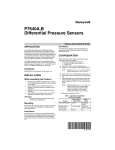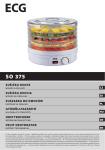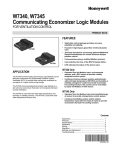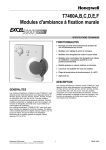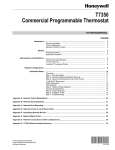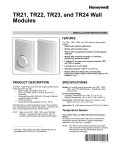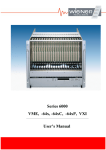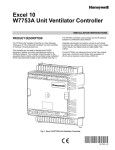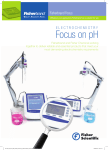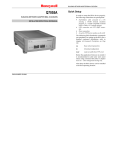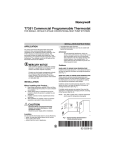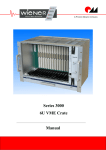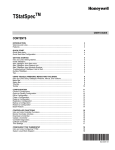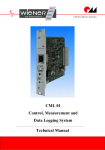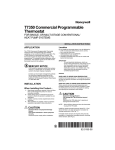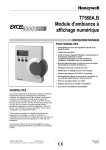Download Series 2000 Humidity/Temperature Sensors
Transcript
H7625A, H7635A, H7626A, H7636A Series 2000 Humidity/Temperature Sensors WALL-MOUNT MODELS INSTALLATION INSTRUCTIONS APPLICATION The H7625A, H7626A, H7635A and H7636A Wall-Mount Humidity/Temperature Sensors are universal Relative Humidity transmitters that can be powered with either a +18 to 40 Vdc or 24 Vac supply. The devices are half wave rectified. The transmitter also includes either a 20K ohm NTC thermistor or a 1K platinum PTC (compatible with the T775) for optional temperature use. The humidity sensors are designed with a field selectable 4 to 20 mA, 0 to 5 Vdc, or 0 to 10 Vdc output signal equivalent to 0 to 100% RH. All units are shipped from the factory with a default setting to accept AC power with three-wire, 0 to 10 Vdc output. INSTALLATION When Installing this Product... 1. 2. 3. 4. Read these instructions carefully. Failure to follow them could damage the product or cause a hazardous condition. Check ratings given in instructions and on the product to ensure the product is suitable for your application. Installer must be a trained, experienced service technician. After installation is complete, check out product operation as provided in these instructions. CAUTION Equipment Damage Hazard. Improper wiring can damage the sensor beyond repair. Follow the wiring instructions carefully. Location Install the device where it cannot be affected by: — drafts, or dead spots behind doors and in corners. — hot or cold air from ducts. — radiant heat from sun or appliances. — concealed pipes and chimneys. — unheated (uncooled) areas such as an outside wall behind the device. Mounting The housing base mounts over standard 2 in. x 4 in. single gang junction box or flush to the wall: 1. Install the sensor about 5 ft (1.5m) above the floor in an area with good air circulation at average humidity and temperature. (See Fig. 1.) 2. Ensure the device receives adequate airflow. 3. Wire the device. (See Fig. 5 through 4.) 4. Ensure proper DIP switch settings. 5. Apply power to the unit. 6. Snap the cover into position. 7. Turn out the 1/16 in. allen screws at the bottom of the enclosure until the cover cannot be removed. CAUTION Electrical Shock or Equipment Damage Hazard. YES Can shock individuals or short equipment circuitry. Disconnect power supply before installation. NO NO NO 5 FEET (1.5 METERS) M4823A Fig. 1. Typical sensor location. Put Bar Code Here 62-0327-03 H7625A, H7635A, H7626A, H7636A SERIES 2000 HUMIDITY/TEMPERATURE SENSORS Output Settings Table 1. Controller Compatibility and Output Settings. The humidity output signal can be adjusted for 0-5Vdc, 0-10 Vdc or 4-20 mA using the switch block. Switches 6, 7, and 8 are used to set the output. Required Sensor Output Setting Controller NOTE: Refer Fig. 2 for switch settings. LONSPEC™ Setting W7750, W7760, W7761 4-20 mA C7600C W7750B,C W7760C, W7753, W7760 0-10 Vdc (default) H7621/31 T7350, XL50, XL100, XL500 XF Modules, XFL 0-10 Vdc (default) n/a Non-Honeywell 0-5 Vdc n/a FACTORY USE ONLY WIRE CONNECTIONS TB1 0-10 VDC OUTPUT (DEFAULT) 4-20mA VIN COM VOUT +TEMP- SW1 ON ON OFF 1 2 3 4 5 6 7 8 0-5VDC OUTPUT OUTPUT, CALIBRATION AND TEST SWITCHES SW1 ON ON OFF 1 2 3 4 5 6 7 8 4-20mA OUTPUT SW1 ON SW1 ON HUMIDITY SENSOR 1 2 S1 P2 3 4 5 6 7 8 ON OFF 1 2 3 4 5 6 7 8 P1 S2 S3 SPAN ZERO TEMPERATURE SENSOR M33151 Fig. 2. DIP switch and Wire Connection locations. REVERSE ACTING OUTPUT mode. When switch 2 is set to ON, the output can be used to show if the unit is in direct or reverse acting mode. For direct acting the output will be 1V for 0-5V, 2V for 0-10V, and 7.2mA for 4-20mA. For reverse acting the output will be 4V for 0-5V, 8V for 0-10V, and 16.8mA for 4-20mA. The output can be changed to reverse acting mode. The output range stays the same but the corresponding RH value is opposite. Direct Acting is the default mode. Example: Direct Acting (DA) 0-10V output mode 0V = 0% RH and 10V = 100% RH With switches 2 and 4 ON, each time switch 5 is set to ON the output will change to reverse acting or direct acting. Reverse Acting (RA) 0-10V output mode, 0V = 100% and 10V = 0% To reset the unit to the default setting, toggle both switches 5 and 6 ON then OFF while both switches 2 and 4 are ON. When all calibration is completed, remember to place the switches back into the positions that correspond to the output needed as shown in Figure 3. To change the transmitter to reverse acting or back to direct acting, set switch 4 ON to put the unit in setup mode. After switch 4 is on, switch 2 will put the unit in direct/reverse acting 62-0327—03 2 H7625A, H7635A, H7626A, H7636A SERIES 2000 HUMIDITY/TEMPERATURE SENSORS WIRING IMPORTANT When using shielded cable, ground the shield only at the controller end (see Fig. 4). Grounding both ends can cause a ground loop. A 16 to 22 AWG shielded cable is recommended for all transmitters. Twisted pair may be used for 2-wire current output transmitters. Refer to Figure 3 for wiring diagrams. mA OUTPUT TRANSDUCER ONLY VOLTAGE OUTPUT SIGNAL TEMPERATURE SENSORTEMPERATURE SENSOR+ 0-10 OR 0-5 VDC OUTPUT SIGNAL SUPPLY GROUND/SIGNAL COMMON SUPPLY VOLTAGE 18 TO 36 Vdc POWER SUPPLY Vin + 4-20mA – CONTROLLER, METER OR RECORDER + INPUT SIGNAL – COMMON TB1 GROUND 4-20mA VIN COM VOUT +TEMP- 2 WIRE CURRENT OUTPUT SIGNAL M22528A TEMPERATURE SENSORTEMPERATURE SENSOR+ Fig. 4. Typical wiring diagram for transducer with two-wire mA output with external DC power supply. SUPPLY VOLTAGE 4-20mA OUTPUT TB1 4-20mA VIN COM VOUT +TEMP- 3 WIRE CURRENT OUTPUT SIGNAL TEMPERATURE SENSORTEMPERATURE SENSOR+ SUPPLY GROUND/SIGNAL COMMON SUPPLY VOLTAGE 4-20mA OUTPUT TB1 4-20mA VIN COM VOUT +TEMPM31180A Fig. 3. Wiring Diagrams CAUTION It is recommended that you use an isolated UL-listed class 2 transformer when powering the unit with 24 VAC. Failure to wire the devices with the correct polarity when sharing transformers may result in damage to any device powered by the shared transformer. 3 62-0327—03 H7625A, H7635A, H7626A, H7636A SERIES 2000 HUMIDITY/TEMPERATURE SENSORS TR23 Remote Sensor 12 11 10 9 8 7 6 5 4 3 2 OUTDOOR AIR SENSOR 1 HEAT RELAY 2 DISCHARGE AIR SENSOR T7350 SUBBASE T5 T6 T7 T4 HS HC T3 OS OS AS AS HP M M X RH COMPRESSOR CONTACTOR 4 W3/Y4 Y3 COMPRESSOR CONTACTOR 2 W2 Y2 Y1 G 5 RC AUX W1 COMPRESSOR CONTACTOR 3 3 MOTION SENSOR VOUT COM VIN (0-10 Vdc) (Vac) COMPRESSOR CONTACTOR 1 HUMIDITY SENSOR 4 1 ECONOMIZER L2 2 FAN RELAY HEAT RELAY 1 L1 (HOT) 1 POWER SUPPLY. PROVIDE DISCONNECT MEANS AND OVERLOAD PROTECTION AS REQUIRED. 2 ENSURE TRANSFORMER IS SIZED TO HANDLE THE LOAD. 3 HEAT/COOL SYSTEMS WITH ONE TRANSFORMER REQUIRE THE FACTORY-INSTALLED JUMPER. 4 USE ECONOMIZER INSTRUCTIONS FOR INSTALLATION DIRECTIONS. 5 HC AND HP PROVIDE 24 VAC TO THE HUMIDITY SENSOR. M31307 Fig. 5. Humidity Sensor (0-10 Vdc output) wiring with T7350 (use with RH/Temperature combination T7350 units only). PWR + – COM O OUT COM O OUT 19 20 21 22 23 2 O VOUT (0-10 Vdc) 1 2 3 4 5 6 7 8 9 10 11 12 13 E GND AI 1 AI 2 AI GND AI 3 AI 4 AI GND AI 5 AI 6 AI GND AI 7 AI 8 AI GND DI 1 DI 2 DI 3 DI 4 25 26 27 28 OUT OUT OUT OUT OUT OUT OUT OUT 1 2 3 4 5 6 7 8 18 + VIN (Vac) + – COM – PWR W7760A 17 H76XX P7640 P7640 + – 24 1 GND GND 29 15 16 ANALOG OUT AO AO 1 2 14 AO GND 24 24 24 24 24 24 24 OUT 21 GND VAC VAC VAC VAC VAC VAC VAC COM VDC COM COM OUT 31 32 33 34 35 36 37 38 39 40 E-BUS 41 42 E-BUS 43 L1 (HOT) L2 1 POWER SUPPLY. PROVIDE DISCONNECT MEANS AND OVERLOAD PROTECTION AS REQUIRED. 2 TEMPERATURE SIGNAL CONNECTIONS ARE NOT POLARITY SENSITIVE. M18302C Fig. 6. Typical wiring diagram for 5-wire temperature/humidity sensor with Vdc output (used with the XL15A controller). 62-0327—03 4 44 H7625A, H7635A, H7626A, H7636A SERIES 2000 HUMIDITY/TEMPERATURE SENSORS HUMIDITY SENSOR 4-20mA VIN COM VOUT +TEMP DO-1 DO-2 COM DO-3 DO-4 COM DO-5 DO-6 COM DO-7 DO-8 COM 24 VAC 24 VAC COM EGND SHLD SBUS1 SBUS2 NET-1 NET-2 AO-1 COM AO-2 AO-3 COM D1-1 D1-2 COM D1-3 D1-4 20VDC U1-1 COM U1-2 U1-3 COM U1-4 U1-5 COM U1-6 2 2 2 2 2 2 2 2 2 3 3 3 3 3 3 3 3 3 3 4 1 2 3 4 5 6 7 8 9 0 1 2 3 4 5 6 7 8 9 0 1 1 1 1 1 1 1 1 1 1 2 9 0 1 2 3 4 5 6 7 8 9 0 1 2 3 4 5 6 7 8 24 VAC + 24 VAC COM M31268 Fig. 7. Typical wiring diagram for 5-wire temperature/humidity sensor with Vdc output (used with the Spyder controller). CHECKOUT Converting Output Signal to Percent RH CAUTION Equipment Damage Hazard. 4 to 20mA Signal Can short electric circuitry. • Never connect 120 Vac to the transducer. • Connect only DC voltage to a transducer intended for DC supply. ((mA signal) -4) / 0.16 = percent RH Example: 12mA output signal (12-4) / 0.16 = 50% RH 0 to 5 Vdc Signal NOTE: Use laboratory quality meters and gauges for applications requiring a high degree of accuracy. 1. 2. 3. (VDC signal) / 0.05 = percent RH Example: 1.25vdc output signal 1.25 / 0.05 = 25% RH Verify that the transducer is mounted in the correct position. Verify appropriate input signal and voltage supply. Verify appropriate configuration range. 0 to 10 Vdc Signal (VDC signal) / 0.10 = percent RH Example: 7.50vdc output signal 7.50 / 0.10 = 75% RH Table 2. Troubleshooting. Problem Items to Check No reading • Verify correct supply voltage at the power terminal blocks. • Verify correct wiring configuration and DIP switch settings per Figures 2 and 3. • Verify that terminal screws are connected tightly with all wires firmly in place. Erratic readings • Verify all wires are terminated properly. • Ensure that there is no condensation on the board. • Verify clean input power. In areas of high RF interference or noise, shielded cable can be necessary to stabilize signal. Inaccurate readings • If you suspect that the transmitter is not reading within the specified tolerance, please contact the factory for further assistance 5 62-0327—03 H7625A, H7635A, H7626A, H7636A SERIES 2000 HUMIDITY/TEMPERATURE SENSORS APPENDIX RH Test and Configuration DIP Switch Settings (Table 3) IMPORTANT • Only adjust these switches for troubleshooting or recalibrating the sensor. (Adjustment is not normally necessary.) Test mode will make the transmitter output a fixed 0%, 50%, or 100% value. The sensor will not affect the transmitter output. This is used for troubleshooting or testing only. Switches 1, 2, and 3 are used for test mode. The output will be a fixed 0%, 50%, or 100% signal that corresponds to the output selected with switches 6, 7, and 8. Refer to Figure 4 for switch settings. TEST SELECTION SWITCHES (SW1) WIRE CONNECTIONS TB1 0% RH OUTPUT SW1 ON 4-20mA VIN COM VOUT +TEMP- ON OFF 1 2 3 4 5 6 7 8 50% RH OUTPUT SW1 ON OUTPUT, CALIBRATION AND TEST SWITCHES ON OFF 1 2 3 4 5 6 7 8 100% RH OUTPUT SW1 ON SW1 ON OFF ON HUMIDITY SENSOR 1 2 3 4 5 6 7 1 2 3 4 5 6 7 8 8 S1 P2 P1 S2 S3 SPAN ZERO TEMPERATURE SENSOR 62-0327—03 M33163 6 H7625A, H7635A, H7626A, H7636A SERIES 2000 HUMIDITY/TEMPERATURE SENSORS Table 3. Test and Calibration Settings (8-Switch Block). Setting 4-20mA Output 1 — 2 3 — — 4 — 5 — 6 — 7 — 8 — 0-5 VDC Output — — — — — On On — 0-10 VDC Output — — — — — — On On 0% RH Output On — — — — — — — 50% RH Output — On — — — — — — 100% RH Output — — On — — — — — Increment RH Output — — — On** On — — — Decrement RH Output — — — On** — On — — Reset to Original Calibration — — — On** On On — — Reverse or Direct Acting — On — On** On — — — Reverse or Direct Acting Reset — On — On** On On — — * = Switch setting does not affect output ** = This switch needs to be activated first — = Indicates OFF 7 62-0327—03 H7625A, H7635A, H7626A, H7636A SERIES 2000 HUMIDITY/TEMPERATURE SENSORS CALIBRATION NOTE: This is only a single point calibration. All transmitters are factory calibrated to meet/exceed published specifications. Field adjustment should not be necessary. The dipswitch allows the user to calibrate the sensor through the software. Setting switch 4 ON will put the transmitter into setup mode allowing the increment and decrement to work. Once in setup mode, the output will change to 50% (2.5V for 0-5V, 5V for 0-10V, 12mA for 4-20mA). Each increment or decrement step will cause the output to change by 0.1V for 05V, 0.2V for 0-10V, and 0.32mA for 4-20mA in setup mode. This can be used to show the user how far offset the transmitter is. To see the starting point again set switch 1 ON. This will show the 50% output again. When the unit is out of setup mode the output will go back to RH output. Decrement RH Output This will shift the RH output linearly down in 0.5% steps. Switch 4 must be set to ON first. After switch 4 is on, each time switch 6 is set ON the RH output will decrease by 0.5%. The decrease goes into effect each time switch 6 is set to ON. Reset RH Output This will reset the RH output back to the original calibration. Switch 4 must be set to ON first. After switch 4 is on, toggle switches 5 and 6 ON then OFF. After 5 and 6 are OFF slide switch 4 OFF. When all calibration is completed, remember to place the switches back into the positions that correspond to the output needed as shown in Figure 3. Increment RH Output This will shift the RH output linearly up in 0.5% steps. Switch 4 must be set to ON first. After switch 4 is on, each time switch 5 is set ON the RH output will increase by 0.5%. The increase goes into effect each time switch 5 is set to ON. Automation and Control Solutions Honeywell International Inc. 1985 Douglas Drive North Golden Valley, MN 55422 customer.honeywell.com ® U.S. Registered Trademark © 2011 Honeywell International Inc. 62-0327—03 S.B. Rev. 11-11 Printed in United States









